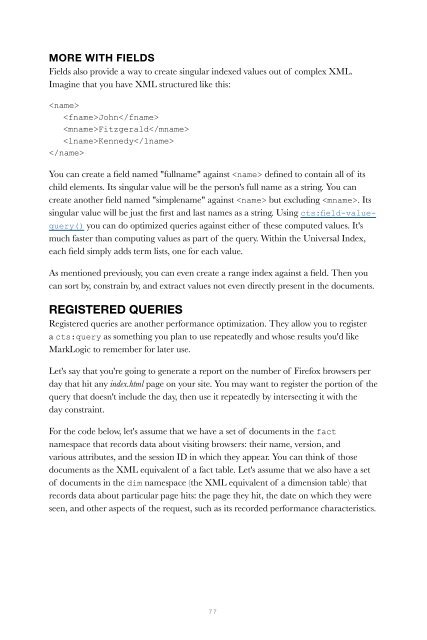You also want an ePaper? Increase the reach of your titles
YUMPU automatically turns print PDFs into web optimized ePapers that Google loves.
MORE WITH FIELDS<br />
Fields also provide a way to create singular indexed values out of complex XML.<br />
Imagine that you have XML structured like this:<br />
<br />
John<br />
Fitzgerald<br />
Kennedy<br />
<br />
You can create a field named "fullname" against defined to contain all of its<br />
child elements. Its singular value will be the person's full name as a string. You can<br />
create another field named "simplename" against but excluding . Its<br />
singular value will be just the first and last names as a string. Using cts:field-valuequery()<br />
you can do optimized queries against either of these computed values. It's<br />
much faster than computing values as part of the query. Within the Universal Index,<br />
each field simply adds term lists, one for each value.<br />
As mentioned previously, you can even create a range index against a field. Then you<br />
can sort by, constrain by, and extract values not even directly present in the documents.<br />
REGISTERED QUERIES<br />
Registered queries are another performance optimization. They allow you to register<br />
a cts:query as something you plan to use repeatedly and whose results you'd like<br />
MarkLogic to remember for later use.<br />
Let's say that you're going to generate a report on the number of Firefox browsers per<br />
day that hit any index.html page on your site. You may want to register the portion of the<br />
query that doesn't include the day, then use it repeatedly by intersecting it with the<br />
day constraint.<br />
For the code below, let's assume that we have a set of documents in the fact<br />
namespace that records data about visiting browsers: their name, version, and<br />
various attributes, and the session ID in which they appear. You can think of those<br />
documents as the XML equivalent of a fact table. Let's assume that we also have a set<br />
of documents in the dim namespace (the XML equivalent of a dimension table) that<br />
records data about particular page hits: the page they hit, the date on which they were<br />
seen, and other aspects of the request, such as its recorded performance characteristics.<br />
77


